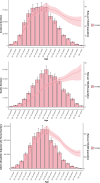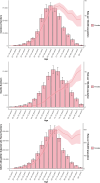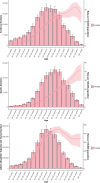Global, regional, and national burden of breast, cervical, uterine, and ovarian cancer and their risk factors among women from 1990 to 2021, and projections to 2050: findings from the global burden of disease study 2021
- PMID: 39988683
- PMCID: PMC11849330
- DOI: 10.1186/s12885-025-13741-9
Global, regional, and national burden of breast, cervical, uterine, and ovarian cancer and their risk factors among women from 1990 to 2021, and projections to 2050: findings from the global burden of disease study 2021
Abstract
Background: Female breast cancer, cervical cancer, uterine cancer, and ovarian cancer (FBCUO) pose a significant threat to global public health. Data from the Global Burden of Disease, Injuries, and Risk Factors Study (GBD) 2021 provide critical insights that can guide the understanding and management of these cancers. Our study aims to offer comprehensive global, regional, and national estimates of the FBCUO cancer burden and its attributable risk factors from 1990 to 2021, as well as project future incidence trends up to 2050. These projections are essential for developing targeted prevention and control strategies, thereby informing more effective public health interventions.
Methods: Incidence, age-standardised incidence rate (ASIR), deaths, age-standardised mortality rate (ASMR), disability-adjusted life years (DALYs), age-standardised rate of DALYs (ASDR), and the burden due to risk factors associated with FBCUO cancer were analysed from 1990 to 2021, and the Bayesian APC model was utilized for forecasting future epidemiological trajectories. All statistical analyses were performed using Join-point software (version 4.9.1.0).
Results: Between 1990 to 2021, the global incidence, death, and DALYs, of female breast, cervical, uterine and ovarian cancer both to varying degrees of elevation. However, the ASMR and ASDR both showed a decreasing trend for FBCUO cancer. In 2021, diet high in red meat was a major risk factor for female breast cancer DALYs, but the attributable ASDR for diet high in red meat decreased from 1990 to 2021. Unsafe sex was the leading risk factor for cervical cancer DALYs, high body-mass index were the leading risk factor for uterine cancer and ovarian cancer. Projections indicate a global increase in the total number of female breast cancer and ovarian cancer cases from 2021 to 2050. In contrast, both cervical cancer and uterine cancer are expected to show downward trends over the same period.
Conclusions: The burden attributable to FBCUO cancers has increased significantly in female populations from 1990 to 2021, underscoring the urgent need for targeted measures to mitigate this trend. Meanwhile, Annual Percentage Change (APC) analysis indicates that the age-standardized incidence rates (ASIR) for female breast and ovarian cancers may continue to rise from 2022 to 2050. This projection highlights the importance of timely interventions to address these growing challenges.
Keywords: Cervical cancer; Disability–adjusted life years; Female breast cancer; Incidence; Mortality; Ovarian cancer; Risk factors; Uterine cancer.
© 2025. The Author(s).
Conflict of interest statement
Declarations. Ethics approval and consent to participate: Not applicable. Consent for publication: Not applicable. Competing interests: The authors declare no competing interests.
Figures










References
-
- Bray F, Laversanne M, Sung H, et al. Global cancer statistics 2022: GLOBOCAN estimates of incidence and mortality worldwide for 36 cancers in 185 countries. CA Cancer J Clin. 2024;74(3):229–63. 10.3322/caac.21834. - PubMed
-
- Chen Z, Xu L, Shi W, et al. Trends of female and male breast cancer incidence at the global, regional, and national levels, 1990–2017. Breast Cancer Res Treat. 2020;180(2):481–90. 10.1007/s10549-020-05561-1. - PubMed
-
- Keyvani V, Kheradmand N, Navaei ZN, et al. Epidemiological trends and risk factors of gynecological cancers: an update. Med Oncol. 2023;40(3):93. 10.1007/s12032-023-01957-3. - PubMed
MeSH terms
LinkOut - more resources
Full Text Sources
Medical

